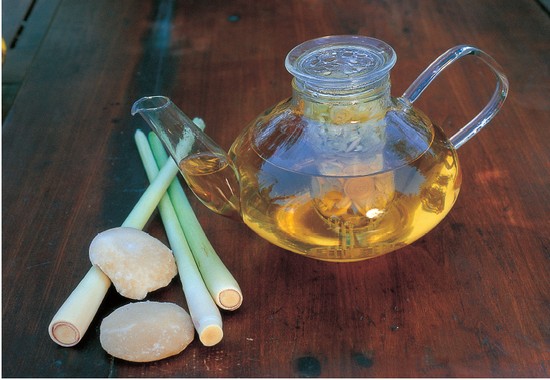
When you candy flowers, if you use confectioners’ instead of granulated sugar you can achieve a matte finish on the flowers, giving them a delicate, old-fashioned look. This cake has been garnished with yellow pansies that were treated in this manner.
Baby roses, Johnny-jump-ups, violets, violas, scented geraniums, orange blossoms, edible pea blossoms (not sweet peas, which are poisonous), and borage are all particularly well suited to candying.
Use candied flowers to decorate cakes, cookies, ice cream, and hors d’oeuvres. Wedding cakes are stunning covered with candied roses, and salmon canapés are dramatic decorated with candied pea blossoms. For an Art Deco presentation, cover a cake with marzipan icing, wrap it with blue French ribbon, and create a cluster of matte-finish, candied blue pansies.
In the cool of the morning on a dry day, select and cut flowers that are perfectly shaped and newly opened. Keep enough of their stems so you can put them in water and later hold them comfortably. Wash the flowers a few hours before working with them so they will be dry.
To candy flowers, you need a small paintbrush, a bowl, cake rack, fork, finely ground granulated sugar (sometimes called bartenders’ sugar or superfine sugar), and an egg white.
In a small bowl, beat the egg white only slightly. Holding a flower by its stem, gently paint the petals with a light coating of egg white, thoroughly covering the front and back because any part of the petal not covered will wither and discolor. Sprinkle the flowers with sugar, making sure to cover both sides of the petals thoroughly. An alternative method is to use a paste mixture of confectioners’ sugar and a little egg white. This mixture gives a matte finish to citrus blossoms and large flowers like dark-colored pansies. Paint this mixture on both sides of the petals.
When your flower is completely sugared, lay it on a cake rack and spread the petals in a natural position. After an hour or two move the flowers around so the petals won’t stick to the rack. Put the flowers in a warm, dry place (I use my gas oven, with just the heat from its pilot light) or in a food dehydrator set on low. After a few days they should be fully dry; store them in a sealed tin. Some of the flowers will become deformed; discard them or break them up to use as a confetti. You can use your candied flowers immediately, but if you store them in a dry place, most varieties will keep for up to a year.
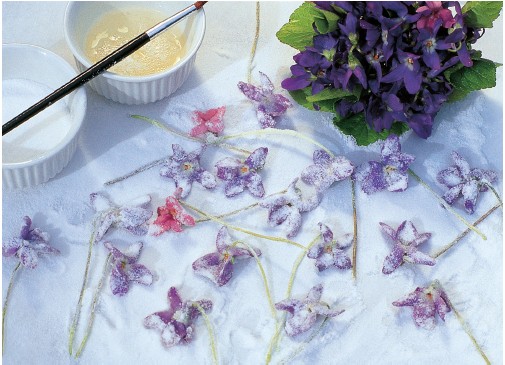
To candy violets or other edible flowers, first give them a light coating of egg white with a paintbrush, being careful to completely cover the petals. With your fingers, lightly sprinkle extra-fine granulated sugar over the petals. Dry them on a rack in a very warm, dry place for a few days or in a dehydrator until firm. Once the flowers are dry, put them in a flat, dry container. Use the flowers to decorate cakes and cookies.
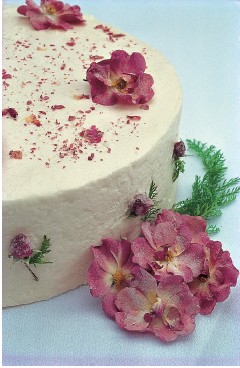
Any broken pieces of candied flowers can be used to sprinkle on confections as you would confetti, as shown here.
Nearly thirty years ago when we moved into our house in California’s Santa Clara Valley we found the remnants of an apricot orchard—four trees. I discovered lots of great recipes for apricots including apricot brandy, glazes for ham, nectar, and this recipe for using our dried apricots.
This lovely bread is a variation on the traditional holiday bread from Verona, Italy, made with raisins and candied fruits. When served as dessert it is usually accompanied by a bowl of whipped cream or mascarpone cheese. It’s also delicious toasted for breakfast.
This particular recipe only works well with rapid-rise yeast, not standard yeast. Using an instant read thermometer eliminates a lot of the guesswork. (See photo on page 190.)
3¼ to 3½ cups (360–370 g) unbleached all-purpose flour
1 teaspoon salt
⅓ cup (75 g) sugar
1 package (7 g) rapid-rising yeast
Zest of 1 lemon
½ cup (125 ml) warm water
2 teaspoons vanilla extract
2 teaspoons apricot or other fruit brandy
4 tablespoons butter, cut into small pieces
2 eggs, at room temperature
⅓ cup (50 g) chopped dried apricots
Garnish: confectioners’ sugar
Blend 3 cups (340 g) of the flour with the salt, sugar, yeast, and lemon zest in the bowl of a heavy-duty stationary mixer, fitted with a paddle attachment. Heat the water to 120 to 130°F (50–55°C). Add the vanilla, apricot brandy, and butter to the water. Add the liquid ingredients to the dry ingredients and beat until smooth. Add both eggs and beat 1 minute longer. Replace the mixer’s paddle with its dough hook and use it to knead the dough, gradually adding the remaining flour until the dough is smooth and silky and pulls away from the sides of the bowl. Just before you finish kneading add the chopped apricots.
Generously butter the pandoro pan. Push the dough down into the pan, cover with plastic wrap, and let rise in a warm place for 1½ to 2 hours or until it comes within 1 inch (2.5 cm) of the top of the mold. After the dough has risen sufficiently, preheat the oven to 350°F (175°C). Bake for 1 hour, or until golden brown and the internal temperature registers 190°F (85°C) on an instant-read thermometer (or until a cake tester inserted into thickest part of the bread comes out clean).
Cool the pandoro in the pan for 10 to 15 minutes before inverting it onto a wire rack. When almost cool, place the pandoro on a serving plate and dust with confectioners’ sugar. Serves 6 to 8.
Note: The cake on page 190 was baked in a traditional fancy star-shaped mold. Similar molds can be purchased from mail-order cooking supply houses such as Sur La Table (800-243-0852; www.surlatable.com) or King Arthur Flour (800-827-6836; www.kingarthurflour.com). You can also use any mold that will hold a yeasted bread recipe calling for 3½ cups (400 g) of flour.
baked apples with cherries and hazelnuts
Baked apples are one of my favorite treats and this recipe beats all the others I have ever had. It’s not too sweet and the strong tart apple flavor contrasts with the sweet creamy whipped cream. Most recipes call for raisins but I especially like it with dried cherries or cranberries.
3 oz (100 g) filbert nuts
6 large baking apples, such as Jonagold, Newtown Pippin, Rome Beauty, Granny Smith, or other firm cooking apple
3 tablespoons finely chopped orange zest
⅓ cup (85 ml) orange juice
2 tablespoons brown sugar
1 tablespoon butter, melted
¼ cup (45 g) dried sweet cherries, cranberries, or raisins
1 cup (250 ml) of heavy cream, whipped
Garnish: thin strips of orange zest
Preheat oven to 350°F (175°C).
Place the filberts on a cookie sheet and bake for 10 minutes. Remove the filberts from the oven, place them on a clean dish towel and rub them to remove most of their skins. Place the peeled nuts in a blender and grind until they are a fine powder.
Core the apples and set them aside. In a small bowl, mix together the orange zest, orange juice, brown sugar, butter, filberts, and cherries.
Stuff each apple with  of this mixture. Place the stuffed apples in a baking pan and bake for approximately 30 minutes or until the they are tender when pierced with a knife. Remove them from the baking dish; place an apple on each of six serving plates and garnish with orange zest strips. Serve with whipped cream. Serves 6.
of this mixture. Place the stuffed apples in a baking pan and bake for approximately 30 minutes or until the they are tender when pierced with a knife. Remove them from the baking dish; place an apple on each of six serving plates and garnish with orange zest strips. Serve with whipped cream. Serves 6.
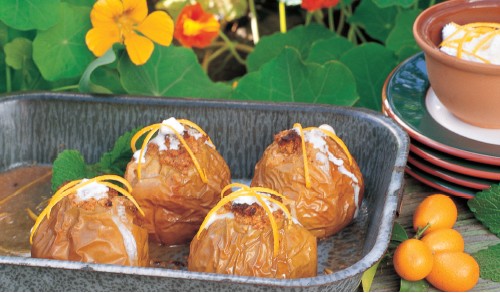
fig needhams
The name of this cookie is actually an inside joke. I grew up in Needham, Massachusetts, and my school’s archrival in football was Newton High School. I bet you these cookies will be better than any store-bought ones you ever had.
For the filling:
1 lb (500 g) of fresh figs, chopped
2 tablespoons water
2 to 4 tablespoons sugar
For the cookies:
1 cup (225 g) butter
1 cup (200 g) brown sugar
2 egg yolks
3 tablespoons milk
2 teaspoons vanilla
2½ cups (280 g) unbleached flour
2 teaspoons cream of tartar
1 teaspoon baking soda
½ teaspoon salt
To make the filling: Place the figs in a saucepan with the water and add sugar to taste (start with 2 tablespoons). Cook over low heat, stirring occasionally, until thick. Makes approximately ¾ cup (190 ml) filling. Any extra filling can be frozen.
To make the cookies: Preheat the oven to 350 °F (175°C). Cream the butter and sugar. Add the egg yolks, milk, and vanilla and beat well. Sift together the dry ingredients and add them to the mixture. Chill the dough for at least an hour.
On a well-floured board, roll out the dough to ⅛ inch (3 mm) thick. Use a round cookie cutter to cut the rolled-out dough into circles. Place ½ teaspoon of the fig filling on half of the dough circles. Cut small holes in the center of the remaining rounds and place them on top of these dough circles, forming sandwiches.
Press the edges of each cookie together with a fork. Bake on an ungreased cookie sheet for 10 to 12 minutes or until slightly golden. Makes approximately 2 dozen cookies, depending on the diameter of the cookie cutter used.
rhubarb and strawberry cobbler
This traditional rhubarb cobbler is surprisingly light and creamy.
For the filling:
6 to 8 stalks rhubarb, cut into ½-in (13-mm) pieces (about 3 cups/360 g)
⅔ cup (150 g) sugar
1 tablespoon orange or lemon zest
1 tablespoon salted butter
1 tablespoon all-purpose flour
3 cups (500 g) sliced strawberries
For the batter:
1¾ cups (195 g) flour
1 tablespoon baking powder
½ teaspoon salt
6 tablespoons salted butter, chilled
½ cup (115 g) sugar plus
2 tablespoons, divided
¾ cup (170 ml) half-and-half
2 tablespoons grated orange or lemon zest, divided
1 cup (250 ml) heavy cream whipped with 1 tablespoon sugar (optional)
To make the filling: In a saucepan over medium heat, cook the rhubarb, sugar, and 1 tablespoon orange zest until the rhubarb begins to juice, about 2 minutes. Add the butter and flour and bring to a boil while stirring. Cook for about 1 minute. Add the sliced strawberries. Remove from heat and pour the fruit mixture into a deep 10-inch (25-cm) pie dish.
To make the batter: Preheat the oven to 425°F (220°C). In a large bowl, sift together the flour, baking powder, and salt. Cut the butter into small pieces. With a fork or a pastry cutter, cut the chilled butter until the mixture resembles coarse crumbs. Add ½ cup (125 g) of the sugar and blend. Slowly incorporate the half-and-half with a fork. Spoon the dough over the fruit mixture in the pie dish. Mix 2 tablespoons sugar and the remaining orange zest and sprinkle it over the top. Bake for 25 to 30 minutes, or until golden brown. Cool slightly and serve with or without whipped cream. Serves 6.
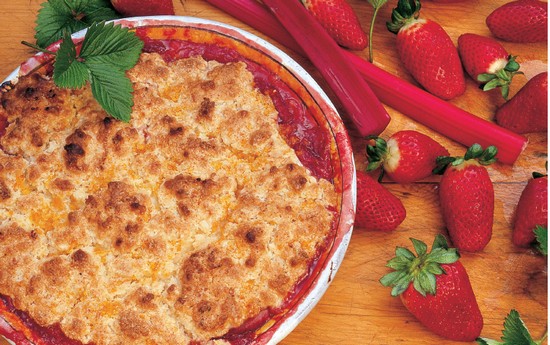
It is not unusual in Italy to have ricotta cheese in a tart. This version is enriched with golden grapes and chard. It makes a lovely, not-too-sweet finale to a meal.
For the crust:
2 cups (220 g) all-purpose flour
½ cup (75 g) ground blanched almonds
¼ cup (60 g) sugar
¾ cup (170 g) butter, cut in small pieces, at room temperature
1 egg yolk
For the filling:
3 eggs
15 oz (425 g) low-fat ricotta cheese
¼ cup (65ml) honey
¼ cup (65 ml) dry white wine
Dash of grated nutmeg
2 cups (75 g) finely chopped golden chard leaves and tender stems (about 5 medium leaves)
1 tablespoon chopped fresh mint
1½ cups (255 g) grated yellow squash (about 1 large squash)
To make the crust: In the bowl of a stand mixer combine the flour, almonds, and sugar and stir. Add the butter and the egg yolk to the dry ingredients. Using the paddle attachment, beat on medium speed until the mixture is the texture of coarse corn meal. Gather into a ball, wrap in plastic and refrigerate for 15 minutes.
Preheat the oven to 375°F (190°C). Press the dough evenly into a 9-inch (23-cm) tart or pie pan. Cover it with parchment paper or aluminum foil and chill the crust for 15 minutes. Before prebaking the shell, fill its cavity with dry beans or rice to weigh down the crust so it will not bubble up. Bake for 10 minutes. Remove the paper and the beans or rice used as weights and reserve.
To prepare the filling: In a mixing bowl, blend the eggs with the cheese, honey, wine, and nutmeg. Then fold in the chard, mint, and squash. Pour the filling into the warm pie shell and bake it on the middle shelf of the oven for 50 minutes or until golden brown. The filling should be set when a toothpick inserted in the center comes out clean. Serves 6 to 8.
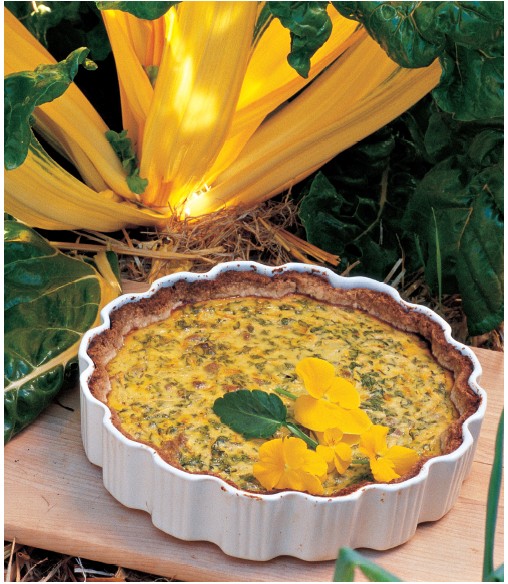
Today Americans think of vegetable pies as being pumpkin or squash, traditionally enjoyed as holiday desserts. However, in Colonial days all vegetable pies, including carrot pie, were similarly spiced and were enjoyed as part of a large farm lunch or supper, not as dessert. Who knows, you may make this pie and start a new family tradition—pie for lunch.
1¼ lbs (625 g) carrots
¾ cup (170 g) white or ¾ cup (150 g) brown sugar
1 cup (250 ml) milk or cream
1 teaspoon cinnamon
½ teaspoon ginger
¼ teaspoon freshly ground nutmeg
⅛ teaspoon allspice or cloves
3 eggs
1 unbaked 9-in (23-cm) pie shell
Wash the carrots and peel the skins if they are tough. Slice the carrots and steam them until tender. (You should have about 4 cups/630 g of sliced carrots.) Purée them in a blender or food processor.
Preheat the oven to 425°F (220°C).
Add the remaining ingredients, except the pie shell, to the carrots in a mixing bowl and blend until smooth and evenly mixed. (You may have to do so in two batches, depending on the blender’s capacity. If so, mix the batches together before pouring the purée into the pie shell.) Pour the purée into the pie shell. Bake for 15 minutes. Reduce heat to 350°F (175°C) and bake for 45 more minutes, or until set. Let the pie cool for at least 30 minutes before serving. Serves 6.
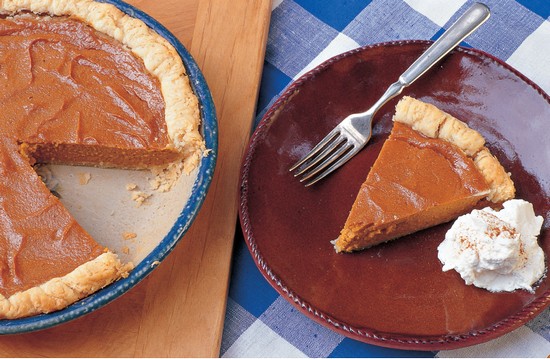
Shortbread cookies lend themselves to all sorts of special flavor variations. Here, I use lavender, but rose geraniums would be tasty too. Shortbread cookie stamps are available from some specialty baking-supply houses.
2 cups (455 g) unsalted butter, room temperature
1 cup (225 g) Lavender Sugar (see recipe, page 38)
½ teaspoon salt
4 cups (440 g) all-purpose flour
2 teaspoons dried lavender blossoms
To make the shortbread: Using the paddle attachment on a stand mixer, blend the butter, lavender sugar, and salt on a low to medium speed until light and fluffy, about 10 minutes. Work in the flour gradually, scraping the bowl occasionally to blend all the ingredients well. Mix in the lavender blossoms. Shape the dough into a ball, wrap it in plastic wrap, and refrigerate it for at least 2 hours.
To shape the shortbread: If you’re using a cookie stamp, cut the dough into golf-ball-size pieces. Roll each piece into a ball with your floured hands, then press it with the lightly floured stamp. Gently remove the stamp and place the formed dough on a cookie sheet lined with parchment paper.
If you don’t have a stamp, roll out the dough on a floured board to about ½ inch (13 mm) thick. Using a cookie cutter or a 3-inch- (8-cm-) diameter water glass, cut out circles and place them on a parchment-lined cookie sheet. Score each cookie with the tines of a fork a few times, making a pleasing pattern. You can also cut the dough into equal rectangles instead of circles.
Refrigerate the formed cookies for 30 minutes before baking them. Preheat the oven to 300°F (150°C). Bake the shortbread for 25 to 30 minutes, or until it is pale golden but not brown. Makes about 2 dozen cookies.
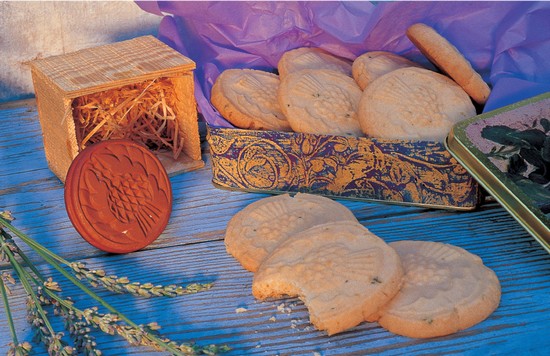
Herb and flower vodkas have either herbs, spices, or fruits added to them. Serve them ice cold. Here is a flavored vodka recipe from Carole Saville, author and herb maven.
2 cups (500 ml) good-quality vodka
1 tablespoon sweet woodruff leaves, or 2 tablespoons fresh lemongrass stalks cut diagonally from the white portion of the base into ¼-in (6-mm) slices, or 1 teaspoon coarsely chopped, fresh English lavender leaves
Combine the herbs and vodka in a very clean wide-mouth pint jar. Seal the jar and allow the mixture to steep for 24 hours at room temperature. Taste for flavoring. If a stronger flavor is desired, infuse the herbs for another 24 hours, or until the flavor suits you. Strain the mixture through a cheesecloth-lined funnel, and pour it into a very clean, decorative pint bottle. Seal tightly with a cork or cap. Store the flavored vodka in the freezer. Makes 2 cups (500 ml).
melon cooler
In a hot climate such as Mexico’s, cool, refreshing fruit drinks are a must—a part of everyday life. Often such Mexican drinks include melons, either watermelon or cantaloupe, from the garden. This version includes tequila but rum could be used, or it could be made without any alcohol at all—it would be equally delicious. The following proportions I find pleasing and not too sweet, but you may want to add more sugar or lime juice. I make it light on the tequila so I can enjoy more than one glass.
½ small watermelon, large seeds removed, cubed
1 to 2 tablespoons sugar
Juice of 1½ limes
2 shots tequila
Garnish: spearmint leaves
Put the watermelon cubes in a blender or food processor bowl, add 1 cup (250 ml) of water, and blend until fairly smooth. (You may have to do this in more than one batch.) Strain the juice to remove the seeds. (This is usually necessary even with seedless watermelons, as they have small white vestigial seeds.) Add the sugar and lime juice, stir, and adjust the flavorings to suit your taste. The mixture can be refrigerated for a few hours at this point.
Before serving, add the tequila and stir. Chill 4 large glasses, then fill them half full of shaved ice. Pour the watermelon mixture over the ice and garnish each glass with mint leaves. Makes about 1 quart (1 liter).

Micheal Isles, chef/instructor in Chico, California, created this fabulous treat. Make the syrup at least two days before making the sorbet.
1 cup (250 ml) rose petal syrup (see recipe below)
1 bottle of late harvest Gewürtzraminer grape juice
4 perfect, large rose blossoms
1 egg white
A day before serving, combine the syrup and grape juice in an ice cream maker. Follow the manufacturer’s directions for making sorbet. Once the sorbet is done, freeze it in an airtight container for 24 hours. You can get away with only 3 hours as an absolute minimum.
To serve, choose four perfect, large roses, remove the centers, spread them open, and secure them to the middle of the plates or dishes with a little egg white. Just before serving, place a scoop of sorbet in each rose. The sorbet may also be served in sherbet glasses or floating in champagne in fancy long-stemmed goblets. Serves 4 to 6.
rose petal syrup
This versatile syrup can be used on crepes or pancakes, drizzled over sponge cake, or used in sorbets. My favorite roses to use are ‘Belle of Portugal,’ ‘Abraham Darby,’ and the spicy Rosa rugosa alba. Try your own varieties for flavor. Some are sensational, others metallic or bitter tasting. If the white bases of the petals are bitter, remove them.
2 cups (200 g) rose petals
⅔ cup (150 g) sugar
Wash the petals and dry them in a salad spinner. Check for insects. Chop the petals very fine. In a medium saucepan, bring 1 cup (250 ml) of water to a boil and stir in the sugar. When the sugar is melted, add the petals. Remove the syrup from the heat and cover it tightly. Let it steep overnight.
Taste the syrup the next day, and if the flavor is not strong enough, reheat the syrup, add more petals, and let it steep overnight again. You can store the syrup in the refrigerator for up to 2 weeks—freeze it for longer storage. Makes 1 cup (250 ml).
Caution: Use only roses that have not been sprayed with commercial chemicals. Diners allergic to sulfur should be particularly careful, as organic gardeners often use sulfur to control rose diseases.
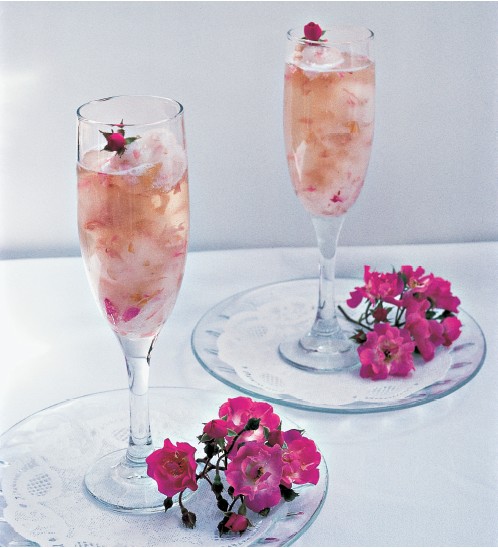
This low-fat smoothie is rich with flavor and perfect for a nutritious breakfast or a light lunch. Frozen persimmons can be substituted for fresh ones. If you do this, peel but don’t defrost each persimmon; cut it into 4 or 5 pieces and eliminate the ice cubes in the recipe. This smoothie can also be made with bananas or peaches instead of persimmons.
½ cup (115 g) nonfat plain yogurt
1½ to 2 tablespoons honey
1 cup (250 ml) nonfat milk or soy milk
2 ‘Fuyu’ persimmons or 1 soft-ripe ‘Hachiya’ persimmon, peeled (remove seeds if there are any)
½ teaspoon vanilla
Dash of cinnamon
2 ice cubes
Garnish: a dollop of yogurt, slices of persimmon
Place all ingredients in a blender and process on medium speed for about 30 seconds, or until the ice cubes or frozen persimmons are crushed. Pour the mixture into a tall shake glass or 2 tumblers. Garnish with small dollops of yogurt and slices of persimmon if desired. Makes 2½ cups (625 ml).
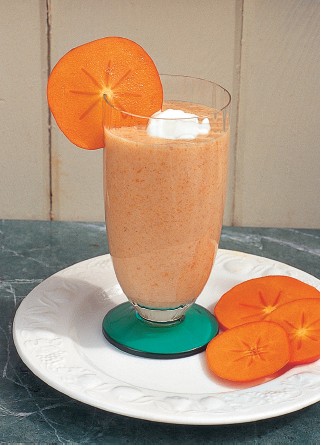
may wine bowl
This recipe is from Rose Marie Nichols McGee of Nichols Garden Nursery in Albany, Oregon, and it is a variation on the traditional libation from Germany. Germans use this traditional punch to celebrate May Day. In Germany sweet woodruff grows wild in the woods and is collected before it flowers, to capture the best taste. Germans use only wilted or dry sweet woodruff and add champagne or sparkling water.
5 bottles Moselle or Riesling wine
2 large handfuls sweet woodruff, cleaned
1 cup (250 ml) brandy
1 cup (225 g) sugar
A large ring mold of ice
1 cup (200 g) strawberries, Alpine or wild, if available
Pour 2 bottles of the wine into a large jar or crock, add 2 large handfuls of dry or wilted sweet woodruff, cover and refrigerate, and let stand for 3 days. Strain the infused wine into a large punch bowl and add the remaining 3 bottles of wine and the brandy, sugar, and ice. Add the strawberries to the bowl and decorate around the base of the bowl with sweet woodruff. Serves about 20.
chamomile cooler
Chamomile is most beloved as a soothing herb tea. The following is my onetime gardener Wendy Krupnick’s iced variation that helps cool a hot day.
1 heaping tablespoon dried German chamomile
1 heaping tablespoon crushed, dried spearmint or peppermint leaves
1 quart (1 liter) apple juice
1 tablespoon lemon juice (optional)
Garnish: lemon slices and fresh mint leaves
Place the herbs in an ovenproof jar or pot. Pour 3 cups (750 ml) of boiling water over the herbs, cover the pot, and let it steep for 15 to 20 minutes. Strain the tea into a large pitcher. Add the apple juice and lemon juice (if desired) and chill. Serve over ice and garnish with lemon slices and mint leaves. Serves 6.
Lemongrass makes a sprightly herb tea. Here, it is made with palm sugar (available from Asian grocery stores), but it is also pleasant with standard white sugar. For a variation try adding a little chopped ginger root. Harvest or purchase 3 or 4 stalks of lemongrass. Use the bottom 3 or 4 inches (8–10 cm) for this tea.
½ cup (35 g) thinly sliced fresh lemongrass
2 to 3 tablespoons palm sugar (or white sugar)
1 quart (1 liter) cold water
Place the lemongrass and the palm sugar in the bottom of a teapot. Bring the water to a boil and pour it into the teapot over the lemongrass. Let the tea steep for at least 10 minutes. Pour the tea through a strainer and into teacups. Serves 4.
chrysanthemum tea
This tea is famous in China and often served with dim sum.
4 tablespoons dried chrysanthemum flowers (shungiku)
1 quart (1 liter) cold water
Place the dried chrysanthemum flowers (shungiku) in the bottom of a teapot. Bring the water to a boil and pour it over the chrysanthemum flowers. Let the tea steep for at least 10 minutes. Pour the tea through a strainer and into tea cups. Serves 4.
